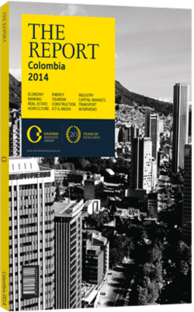Production and exports of cosmetics are growing in tandem
One of the most successful sectors under the Productive Transformation Programme (Programa de Transformación Productiva, PTP) is cosmetics, which has drawn in foreign direct investment from numerous multinationals, has grown faster than the economy at large and has transitioned from being a net importer to a net exporter in the past 15 years.
Productivity & Domestic Sales
Cosmetics manufacturing and domestic sales have grown in step with one another. Both production and sales were around $800m in 2001 and grew towards $2bn during the next decade, with production surpassing this figure in 2012. The growth in cosmetics consumption has coincided with a tripling of Colombia’s GDP per capita, which has benefitted most of the fast-moving consumer goods sectors. However, the cosmetics sector has been an especially big winner in part due to the increase in Colombian women’s purchasing power. Colombia has the highest rate of women in managerial positions in Latin America and the country saw the participation of women in the workforce expand by 23% between 2000 and 2010, compared to 15% in Latin America overall. Multinationals have rushed to claim their share of the market. In 2010 foreign companies accounted for 74% of domestic sales. Avon, Procter & Gamble, and Unilever were the market leaders with 16%, 15% and 13% market shares, respectively.
Exports
As production for the domestic market has expanded, Colombia has emerged as a manufacturing base from which multinationals export to Latin American countries such as Mexico and Peru. Exports have grown from a very low base and as a result have risen at an even faster rate than production, increasing from $70m in 2001 to $542m in 2012. (Imports grew from $104m to $399m in the same period.) The primary export markets have been Colombia’s neighbours. In 2013 Ecuador received 32% of Colombian exports of cosmetics and toiletries (which the Colombian government often groups for statistical purposes). Peru took 29% and was followed by Venezuela (18%), Mexico (12%), Costa Rica (5%) and Panama (4%). Since 2001 cosmetics exports have grown every year except 2009 and 2010. However, in January and February 2014 cosmetics exports fell by 21% compared to the same period a year earlier, from $98m to $78m. The contraction was largely the result of declines in exports to Ecuador, which nearly halved from $23.1m to $11.7m, and to Peru, which fell from $25.9m to $20.5m, according to the Directorate of National Taxes and Customs.
Research & Development
Cosmetics giants also have research and development (R&D) facilities in Colombia. Several incentives created by the government have promoted this development. Colombia has striven to shift its labour force towards a higher proportion of engineers, researchers and highly skilled technicians. The incentives offered to establish R&D facilities have been part of this effort. As long as a company commits to staff a new R&D facility with at least 75% Colombian workers within three years, the government will heavily subsidise wages during this time. In the first year the subsidy is 90% of wages for an employee with a PhD and 75% for one without. By the third year these subsidies decline to 70% and 55%, respectively. Additionally, an income tax deduction is available worth 175% of the amount invested in a qualifying R&D facility, as long as this amount does not exceed more than 40% of net income. Furthermore, equipment purchased for R&D facilities is not subject to value-added tax, and income derived from R&D is not taxable. It is not permitted to use all of these deductions in conjunction with one another. Several foreign companies now operate cosmetics R&D centres in Colombia including Belcorp, a Peruvian company that invested $10m in a plant and research facility in Tocancipá, and Kimberly-Clark, which in 2011 announced plans to open an R&D centre with Benefitting from increasing domestic consumer power and emerging as a viable exporter and stimulating investment in R&D, the cosmetics sector is the picture of what Colombian industry would like to become.
You have reached the limit of premium articles you can view for free.
Choose from the options below to purchase print or digital editions of our Reports. You can also purchase a website subscription giving you unlimited access to all of our Reports online for 12 months.
If you have already purchased this Report or have a website subscription, please login to continue.

